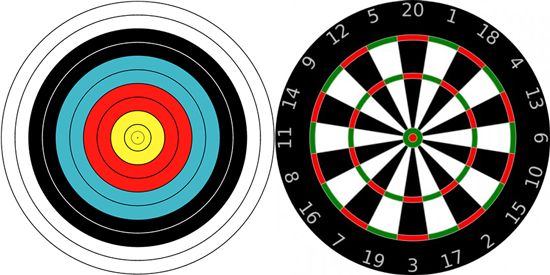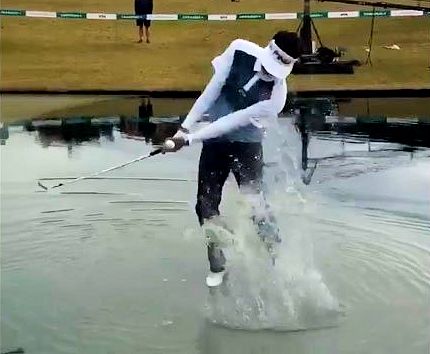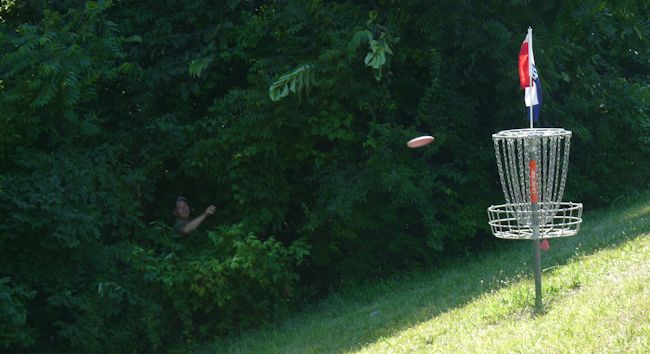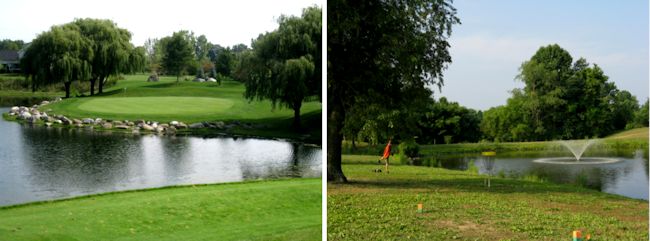Better Granularity, Better Sports
Better Granularity, Better Sports
Opportunities within disc golf

What is Granularity?
Granularity in games and sports is a combination of two factors: scoring progression and penalty progression. First, how well does the scoring system incrementally reward increasingly better execution? And second, how well are penalties incrementally applied based on how severely a competitor failed to execute?
Most target sports have excellent scoring granularity. In archery, an archer is awarded 10 points for an arrow that lands in the center circle with the value of each ring decreasing by one point as the arrows land farther from center. The more skillful the shot, the higher the score. Plain and simple.
Compare this to darts and weaker granularity quickly becomes apparent. One dart can score from one to 20 points when landing the same distance from center as another dart, and score even higher with a wider range at equidistant points farther from center. Sports like running or swimming have even more precise scoring granularity than archery, with times measured to thousandths of a second.

Archery board (left) and dart board (right) provide different levels of granularity for scoring.
Sports with minimal scoring granularity like soccer or hockey rely on granular incremental penalties to help determine which of the two teams played better. A goal counts as just one, no matter how well the team/scorer executed the play required to score. Contrast this with American football, AKA gridiron football, a sport with much better scoring granularity. There are increasingly more skillful ways required to score one, two, three, or six points.
The ruling bodies of soccer and hockey have graduated penalties for offsides, fouls, icing, hand ball, high sticking, etc. These are all infractions where the short term advantage provided to the other team is proportionally related to the severity of the transgression.
"Reestablishing competitive balance" or "leveling the playing field" are typical phrases you'll hear when a sport's ruling body works to improve their scoring or penalty granularity. For example, basketball added the 3-pointer many years ago which increased scoring granularity. The NHL has considered and one day may implement an increased goal size. Gridiron football at all levels has been tweaking their penalty granularity in an effort to reduce injuries, and the NFL recently increased scoring granularity by moving the extra point line from the 2 yard line all the way back to the 15 yard line.
Golf Granularity
How granular are ball and disc golf? Could our granularity factors be improved? The PDGA Board of Directors recently approved the Game Development Team to work with tournament directors to test ideas in the areas of rules, equipment, and course design to discover if any new concepts might improve our game for some or all divisions. Improving granularity, or simply not reducing the existing granularity, will be one of the most important evaluation criteria.
"Risk/reward" is a term used in disc golf to describe course design elements where, in theory, the better the player executes a throw, the better his/her chances are to earn a lower score on the hole. Or the inverse, meaning the worse the player executes a throw, the harsher the penalty. The goal for each risk/reward element for good course design should be progressive granularity for both the scoring and penalty elements.
Ball Golf
Ball golf has had more than 400 years of experience that has developed a relatively smooth granularity in its penalty structure. Scoring appears nicely granular on the surface, with each shot counting as one. However, the characteristics of each shot can look quite different, ranging from a 325-yard slice off the tee to a tap-in putt on the green. Both of those shots count as one, just like a goal in soccer.
But, since every player must ultimately end up in the hole, there's no need to evaluate and score the quality of each shot. Just count the total shots until holing out to indicate the cumulative quality (or lack) of all shots. Play enough different holes and a more precise measurement emerges to determine players skill differences.
Ball golf achieved good penalty granularity by incorporating a variety of less desirable landing areas in hole designs, e.g. sand traps, short rough, high rough, trees, waste areas, water hazards, etc. A ball that lands in these areas cumulatively produce percentage penalties; less than a 1-stroke penalty per lie based on the probability a player will "save" a stroke from their unfavorable lie.
For example, if a player develops the skill to save a shot three out of four times when landing in a green-side sand trap, landing in the trap has the equivalent of a 0.25 stroke percentage penalty (one stroke lost in four lies). The player who saves only three out of five times in the same trap suffers a percentage penalty equivalent to 0.40 stroke (two strokes lost in five tries).
On many holes in ball golf, there's no location a ball can land that earns an immediate penalty stroke, including very shallow water where players are allowed to play their next shot with a splash. The only immediate penalty location on some holes is true out-of-bounds, typically only achievable with a bad slice that completely leaves the property. Ball golf course designers try to build holes so that only the most severe slices ever go out-of-bounds, earning the dreaded stroke-and-distance penalty.

Bubba Watson #44745, playing it as it lies.
Most but not all water landings do result in a 1-stroke penalty, since players usually aren't able to find or play their ball. However in addition to the stroke, a percentage penalty does result from how much distance is lost ranging from zero to the full length of the shot that entered the water. In ball golf, every 22 yards raises the cumulative scoring average for scratch golfers by about 0.1 strokes. Even water hazards produce a granular percentage penalty similar to sand traps and rough.
The underlying principle that helps produce this smooth penalty granularity in ball golf is "Play it as it lies." This results in a percentage penalty of less than one stroke per lie, most of the time. When a player cannot play from the lie and/or chooses to relocate, it's a one stroke penalty plus a percentage penalty for the shortest possible lost distance.
The United States Golf Association (USGA) has avoided forcing a re-hit with or without a 1-stroke penalty unless deemed absolutely necessary due to: (1) "Play it where it lies" principle, (2) penalty too severe for the miss-hit, and (3) slowing down the game. The current stroke and distance penalties for a lost ball and out-of-bounds have been simply one stroke or just the lost distance at various times during the 1900s. Even now, it's quite common for recreational players to just accept a player taking a 1-stroke penalty and playing their lost or OB shot in-bounds from where last seen in-bounds.
Disc Golf
With the finer points of ball golf granularity explored, let's look at how disc golf has adopted ball golf elements to try to duplicate similar granularity. It was apparent right away that the "Play it as it lies" principle in ball golf had to become "Throw it from where it lies" for disc golf. Unfortunately, most of the percentage penalty areas like the sand traps and rough of ball golf do not impact disc golf play in the same way, although landing in the woods remained a key element in a similar way to ball golf. Landing a disc in sand, rough, mud, rocks, and even shallow water has minimal impact to granularity in disc golf, as it is often still fairly easy to throw from those hazards.
Instead of using different ground surfaces, our primary means of producing percentage penalty granularity for a thrown disc is using vertical obstacles, typically trees. Trees have worked well for 40+ years to provide percentage penalty granularity where striking a tree can lose distance and proportionately increase the challenge of the next throw, depending on where the disc lands after striking the tree.
However, if a course has few trees, designers have struggled to develop other ways to produce percentage penalties outside of simply adding length. Increasing distance has been a key designer option in disc golf, where every 30 feet adds about 0.1 throw average to the score for scratch players. Unfortunately for many courses, lengthening holes isn't always an option due to property constraints.

Brad Schick #7992 playing out of the woods at the Brent Hambrick Memorial Open.
Casual water provides some percentage penalty granularity whether the player throws from there with a more restricted stance or loses a small amount of distance by relocating. However, "casual water" means that the water may not always be there as a consistent hazard.
Permanent bodies of water and concrete on or bordering fairways have historically been called "out-of-bounds" versus a "hazard" in ball golf. This may have been an unfortunate slip in our terminology, as ball golfers that become disc golfers think of out-of-bounds as places where a full stroke and distance penalty should apply. Fortunately, our OB penalty default has been set at just one throw plus some percentage loss of distance depending on the last point the disc was over or touching the in-bounds playing surface.
Artificial ground hazards, e.g. marking off an OB area with string or paint, usually incur at least a 1-throw penalty and possibly a percentage penalty for lost length. These marked areas add imbalanced granularity to produce scoring separation on more open property. But both artificial and natural OB penalty areas fail to produce the equivalent percentage granularity produced by well done wooded course designs. The OB penalty incurred by a bad throw on an open course is far higher in comparison to a similar bad throw on a wooded course that results in hitting a tree.
Requiring the throw and distance penalty for a marked area in the field of play reduces comparative granularity (compared to a wooded course) even more and is actually against the PDGA Official Rules of Disc Golf without an approved request from the PDGA Tour Manager. The Game Development Team hopes to develop and test some new percentage penalty options, some averaging less than a 1-throw penalty that designers and tournament directors can use to add appropriate granularity challenges on holes and courses where trees are scarce.
Granularity in Putting
On a ball golf green, the ball must regularly traverse an undulating surface that may go uphill, downhill, left, and/or right. Even the professionals average close to two putts around the green to complete the hole when including fringe chips in the count. Scoring spread results from a nice mix of one, two, or three skillful putts per hole at the pro level. That said, putting length and terrain produce smooth granular penalties to measure putting skill.
Putting in ball golf also has a different look and type of equipment (putter) used to execute shots towards a circular hole consistent from all directions. Many viewers indicate that shots around the green, especially putts, are the easiest to see and the most interesting to watch, compared to drives and fairway shots.
How does the putting environment in disc golf stack up? Well, for starters, course owners/designers rarely build well-defined greens because there are minimal rules that significantly differentiate putting from other shots.

Ball golf green (left) and disc golf "green" (right).
Often misunderstood, the 10-meter circle around the target in disc golf does not define where a putt or a putting stance must be taken. It simply regulates a player's balance requirement when executing the shot. An observer might not notice anything different when watching a player putt from eight meters, and then watching that player again putting from 12 meters. No different equipment is used, the ground surface looks the same, and there's minimal or no difference in how the player executes the throws.
Official disc golf targets are not uniformly circular (12 repetitive sections) like a hole in ball golf. Targets include a variety of visually different models and are more likely than a ball golf hole to randomly reject putts that appear to be going in. The route for a putt is usually straight, even if throwing uphill/downhill. Inconsistent wind speed and direction are sometimes taken into account, but certainly not every time. Without much wind, there's usually nothing between the player and the target to affect a throw in a way that would be considered equivalent to grass friction and terrain undulations on a ball golf green.
Regardless, as most of us have experienced, disc golf putting has proven to be challenging enough to provide decent scoring spreads for players ranging from brand new recreational players to seasoned pros. However, for the top touring professionals, not only is granularity weaker (less scoring spread), but we're also missing the look, drama, and distinctive putting environment found in ball golf. Our top level players have become so good at putting that, when throwing from the hypothetical "green", an average of just a few tenths higher than one throw is all that is needed to hole out. In other words, once inside or near the 10m circle, there's a minuscule chance of a missed putt.
This discussion was not meant to be a takedown of disc golf as it is today. We believe the game more than holds its own vs ball golf as an equally fun but more reachable form of golf for the recreational masses. We know disc golf is growing fast while ball golf has stalled in growth in recent years. That being said, it doesn't mean some of the equipment and mechanics of our game as dissected above couldn't be improved. Hopefully, we can borrow some of the game design concepts ball golf has fine-tuned over its storied history and recast them to work in disc golf's favor.
A key mission for the new PDGA Game Development Team is to seek out and test ideas and equipment proposed to enhance granularity, fairness, fun, or simply interest in a fiscally feasible fashion. And, more importantly, the mission is to not screw up the greatness we already have in our beloved game.
- posted 1 week ago
- posted 2 weeks ago
- posted 2 weeks ago
- posted 3 weeks ago
- posted 3 weeks ago
- ‹ previous
- 2 of 732
- next ›

Comments
I still contend that it is
I still contend that it is important to recognize that the score on a hole, now and forever will
be the combination of skills.....and putting is just the last shot on a hole.
Over all course design, length, obstacles, and putting environment are all important.
I vote (in lieu of total overhaul of designs) for the small target. I suggest trying it on an A Tier event, that doesn't have NT points impact.
Compare results to same event in years past, and use player feedback to determine future use.
Smaller basket is the least
Smaller basket is the least likely of the various ideas to be tried simply because a manufacturer would have to step up and create enough of those baskets for testing. We have other ideas that can be tested right away or with less difficulty that may be better than a smaller basket in the first place. Regardless, we hope over time that all the variuos ideas can be tested.
Making one side of the basket
Making one side of the basket smaller and incentivizing players to place approach shots on the side of the basket that is the normal size could be an great way to add some challenge to a more simple hole and I think it would be a crowd pleaser to see players make putts from the side the basket that is more difficult. This really needs to be looked at. It would not have to be expensive when testing and it would not take long to decide if it would be worth continuing.
A couple versions of that
A couple versions of that idea are on the list of options to test.
Some ball golfers practice
Some ball golfers practice with a hole that is smaller than regulation. If they made this the normal hole, all of the greens could be effectively shrunk, because there's really no chance of hitting a 50 footer, like the reason why current greens aren't typically 100 ft. So the distance where the player is expected to hole out in two strokes is basically a good working definition of "putting area" for both sports. If you 1 putt you did something special, if you 3 putt you screwed something up. Smaller baskets in disc golf will shrink this distance. Maybe it'll be better for spectating, but like cgk points out, that's a tall order for manufacturers.
Another point - we need to come to terms with the limits of tree-scarce courses. The real beauty of disc golf (vs. ball golf) is shot shaping. Try making a ball do an "S" turn. Shape that "S" through trees, and its a thing of wonder. Discs fly, balls plummet and fall. I think it'd be more healthy for the sport to admit this from the get-go than try and add gimmicks to tree-less courses that are big-crowd friendly. You can still have fun on the tree-less courses (with no penalty drop zones, for example), but they will never display disc golf in all its flying glory. Mandos can help, if you can have just a few trees, however. Make me shape shots left-right, right-left, etc...
I agree that making ALL shots
I agree that making ALL shots on a consistent basis, especially with TITLES on the line and the pressure is HIGH that separates a good player from the elite players.
As far as a testing ground for a smaller target, please correct me if I am wrong, but to try this experiment at an A Tier event, on strictly a trial level, wouldn't there only need to be 18 smaller targets ? Even if it is a multiple course event, which is rarely the case unless it is a MAJOR or a NT Tournament, I suggest using the smaller targets on just 1 course that gets used equally by all participants.
Believe me, I am not trying to be difficult, but this seems to me like the most logical and feasible thing to implement. Plus, it does not make gimmicky changes to the sport.
I don't know, it's just a thought.
Like I said, we would need a
Like I said, we would need a manufacturer to step up and make the 18 proto baskets and maybe more for testing. There are other ideas being discussed that are less expensive, may be more effective and can be tested much easier than smaller baskets. And no windmills involved.
LOL.....Ok, that was a good
LOL.....Ok, that was a good one, no windmills involved.
I do appreciate every body who is involved in this program, I want to contribute to the growth of this sport in any way that I can.
I admit to being somewhat traditional,,,,,(even follow National League baseball team, we still make the pitchers HIT for themselves !)
Thanks for listening !
CP
Could simply zip tie the
Could simply zip tie the chain rings to the top of the basket during nt events. Reducing the hang length of the catching surface substantially increases difficulty without an additional equipment cost for the course.
I haven't read every comment
I haven't read every comment here, but given the large discussion on basket design and size, I think it's important that we carefully think about baskets. Why shrink a basket and fundamentally change the structure of how we play? IMO a better solution is to codify the basket design, and make the disc catching nature of the basket a more subtle one. Players that bounce out, or that slice through have actually done something wrong. Case one, the angle of the disc was wrong, case two, they putted too hard, or at a side to side angle. A putt that involves a solid forward motion, a recognition that the disc has to fall into the basket and a basket that requires subtlety is very different than a rocket driven hard at the basket and a basket that will catch anything. Increasingly, the manufacturers have made the catch all basket, extra chains, more depth etc. Going back to the first pole hole might be the answer.
The original baskets had one set of chains, and if you drove hard into them, you went through. Players began to add more chains. The truth is that this could be tested very easily. Indeed, the information may already be available based on courses still in existence. Find a course that had old style baskets, that got an upgrade, and you'd have a measure. Not a great one, but a place to start.
Just a reminder, the reason we added chains was the spit through problem. Maybe we should have left well enough alone....
Pages